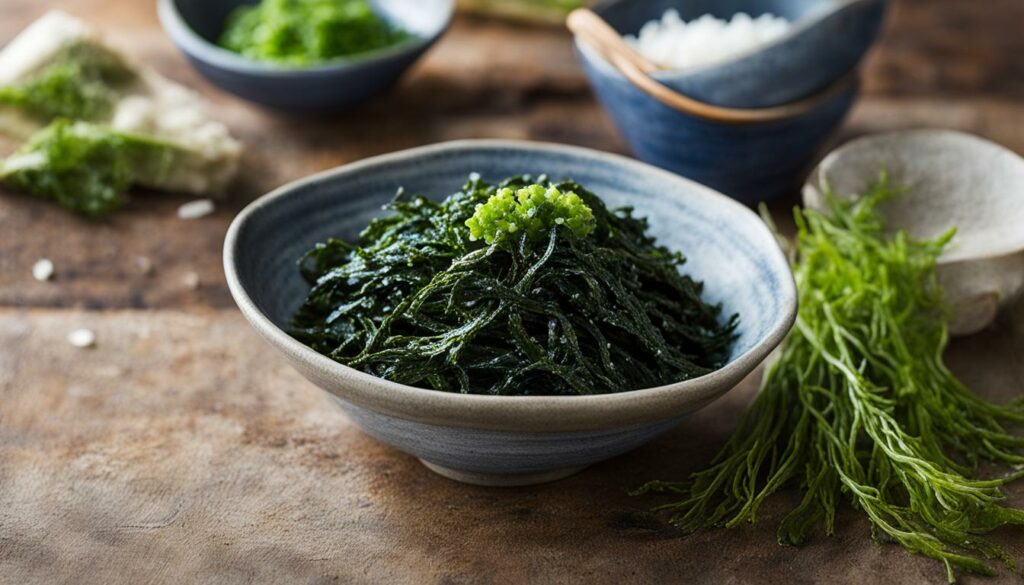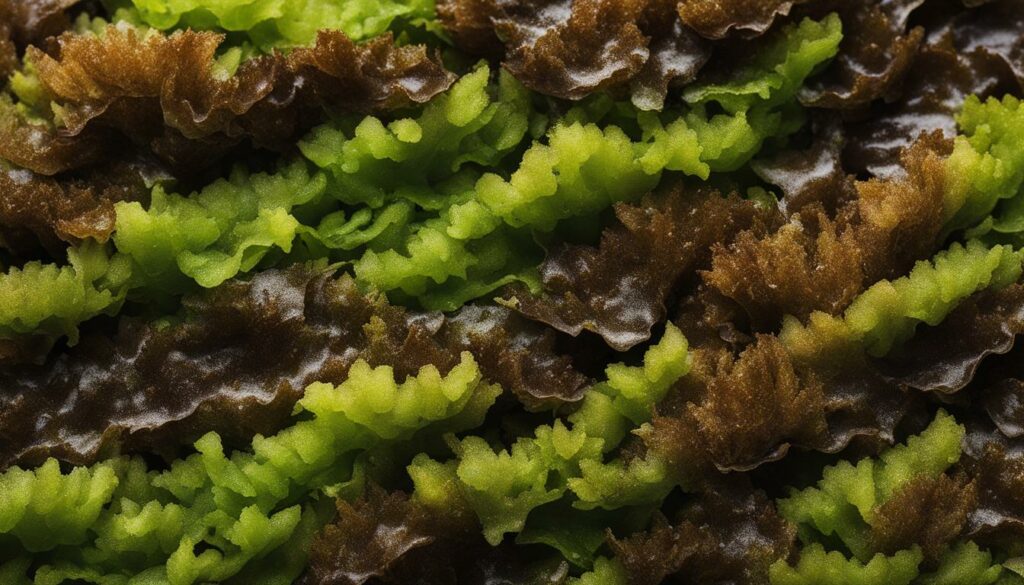Have you ever tasted seaweed? This edible plant, also known as sea vegetable, marine algae, or marine plant, has gained popularity in recent years as a versatile ingredient in various dishes. But what does seaweed taste like? Let’s dive in and find out.
Before we explore the flavor profile of seaweed, let’s first understand what it is. Seaweed is a type of marine plant that grows in saltwater, ranging from shallow coastal waters to deep ocean depths. There are various types of seaweed available, including sea lettuce, kelp, nori, kombu, wakame, dulse, arame, hijiki, sea moss, and seagrass, each with its unique taste and texture.
When it comes to flavor, seaweed has a distinct taste that is hard to describe. Some people describe it as umami-rich, with a subtle salty and briny essence that reminds them of the ocean. Others say it has a mild, earthy, or slightly grassy taste, depending on the type of seaweed.
But what makes seaweed an intriguing ingredient is how it can enhance the flavors of various dishes. It can add a savory depth to soups and stews, a crunchy texture to salads and sushi rolls, and a unique umami taste to sauces and dressings.
So, what does seaweed taste like? The only way to truly know is to try it yourself and discover the unique flavors that this marine plant has to offer.
Key Takeaways:
- Seaweed is an edible marine plant that grows in saltwater.
- It has a distinct taste that is hard to describe, ranging from umami-rich to mild and grassy.
- Seaweed can enhance the flavors of various dishes and add a unique umami taste.
- There are various types of seaweed available, including sea lettuce, kelp, nori, kombu, wakame, dulse, arame, hijiki, sea moss, and seagrass.
- The only way to truly know what seaweed tastes like is to try it yourself.

Understanding Seaweed: A Brief Introduction
Seaweed is a fascinating edible plant that has been consumed by coastal civilizations for centuries. It belongs to a group of large, multicellular algae known as sea vegetables, which are commonly found in marine environments across the globe. Seaweed is often referred to as marine algae or marine plant, and comes in various shapes, sizes, and colors.
There are many different types of seaweed, each with its own unique characteristics and flavors. Some of the most popular types of seaweed include:
- Sea Lettuce – delicate and grassy flavor
- Kelp – rich, slightly sweet flavor
- Nori – nutty, umami flavor
- Kombu – savory, umami flavor
- Wakame – mild, sweet flavor
- Dulse – smoky, bacon-like flavor
- Arame – mild, slightly sweet flavor
- Hijiki – earthy, slightly sweet flavor
As an edible plant, seaweed has been used in various cuisines across the world, from sushi to miso soup. Its unique flavor and versatility make it an excellent addition to many dishes.
Now that we have a brief introduction to seaweed, let’s delve into its taste and explore its nutritional value.
Exploring the Oceanic Flavor Profile
Have you ever wondered what the ocean tastes like? Seaweed comes pretty close to offering you a taste of the sea in all its briny glory. Its flavor profile can be described as umami-rich, with a subtle salty taste that adds depth to various dishes.
The umami taste in seaweed comes from glutamic acid, an amino acid that’s also found in other umami-rich foods like mushrooms and soy sauce. The savory flavor of seaweed is what makes it an excellent ingredient in many dishes, especially soups, stews, and sushi rolls.
“The flavor of seaweed is best described as umami-rich, with a subtle salty taste that adds depth to various dishes.”
When you taste seaweed, you’ll instantly recognize its oceanic essence. The briny taste of seawater naturally infuses the marine algae with a salty flavor that varies in intensity depending on the type of seaweed you’re eating. Some varieties like dulse and nori have a mild and slightly sweet flavor, while others like kelp and hijiki have a more intense and robust taste.
Seaweed’s flavor can also be affected by the environment where it grows. Seaweeds that grow in colder waters tend to have a more intense flavor compared to those grown in warmer waters. The season when it’s harvested can also affect its flavor since seaweed’s taste is at its peak during certain times of the year.
In summary, seaweed offers a unique blend of umami and salty flavors that draw inspiration from the ocean.
Taste Descriptions of Different Seaweed Varieties
Each type of seaweed has a unique taste profile that adds depth and flavor to your culinary creations. Here are some of the most popular varieties of edible seaweed:
| Seaweed Type | Taste Description |
|---|---|
| Sea Lettuce | Has a mild and slightly sweet taste that resembles lettuce. It’s often used in salads or as a garnish. |
| Kelp | Has a savory and umami-rich taste, with a subtle sweetness. Kelp is commonly used in broths, soups, and stews. |
| Nori | Has a slightly sweet taste with a nutty flavor and strong umami notes. It’s the most commonly used seaweed in sushi and also makes a great snack. |
| Kombu | Has an intense savory taste with a slightly sweet finish. It’s often used as a flavor enhancer in broths, stews, and marinades. |
| Wakame | Has a delicate and slightly sweet taste with a soft texture. It’s often used in salads, miso soup, and other Japanese dishes. |
| Dulse | Has a chewy texture and a smoky, salty taste that makes it a popular snack. It’s also used in soups, stews, and as a seasoning for vegetables. |
| Arame | Has a mild, slightly sweet flavor with a tender texture. It’s often used in salads, stir-fries, and soups. |
| Hijiki | Has a strong, earthy taste with a slightly sweet finish. It’s commonly used in Japanese cuisine, often paired with vegetables or tofu. |
Try experimenting with different types of seaweed to discover your personal preferences and create exciting flavor combinations.

Culinary Uses and Flavor Pairings
Seaweed is a versatile ingredient that can be used in various culinary ways due to its distinct flavor and texture. Its salty and umami-rich taste adds depth to soups, stews, and sauces, while its crunchy texture makes it an ideal topping for salads, poke bowls, and sushi rolls.
As an edible plant, seaweed can be used fresh, dried, or roasted, depending on the desired outcome. When using fresh seaweed, it’s essential to rinse it thoroughly and blanch it in boiling water for a few seconds to remove the excess saltiness and bring out its bright green color. Dried seaweed can be rehydrated in cold water before being used in recipes, while roasted seaweed can be used as a snack or crumbled as a seasoning.
One of the most popular culinary uses of seaweed is in sushi. Nori, a type of seaweed, is used to wrap sushi rice and other ingredients, giving it a unique flavor and appearance. However, seaweed is not limited to sushi alone and can be used in various dishes such as ramen, miso soup, and even burgers.
Flavor Pairings
When it comes to pairing seaweed with other ingredients, the possibilities are endless. The salty and umami-rich taste of seaweed pairs well with seafood, mushrooms, soy sauce, and ginger. It can also be used to add a unique flavor to meat dishes and roasted vegetables.
Here are some popular flavor pairings that complement the taste of seaweed:
| Ingredient | Pairing |
|---|---|
| Seafood | Nori, Kelp, Wakame |
| Meat | Arame, Dulse, Kombu |
| Mushrooms | Nori, Kombu, Sea Lettuce |
| Soy Sauce | Nori, Kombu, Wakame |
| Ginger | Arame, Kombu, Wakame |
Experiment with different flavor combinations to create unique dishes that showcase the taste of seaweed. Whether you’re a seafood lover or a vegetarian, seaweed is an ingredient that can add depth and complexity to your cooking.

Health Benefits and Nutritional Value
If you’re looking for a nutrient-dense addition to your diet, look no further than seaweed. This edible plant, which belongs to the marine algae family, is packed with essential vitamins and minerals that offer a range of health benefits.
Seaweed is an excellent source of iodine, a mineral that is essential for thyroid function and helps regulate metabolism. It’s also high in calcium, magnesium, and iron, all of which contribute to healthy bones and muscles.
Furthermore, seaweed is rich in antioxidants, which help protect your cells from damage caused by free radicals. The high levels of polysaccharides and fiber found in seaweed can also help regulate blood sugar and cholesterol levels.
The Nutritional Value of Seaweed
| Nutrient | Amount per 100g |
|---|---|
| Calories | 45 |
| Protein | 3g |
| Fat | 1g |
| Carbohydrates | 9g |
| Fiber | 1g |
| Calcium | 168mg |
| Magnesium | 121mg |
| Iron | 2.3mg |
| Potassium | 233mg |
| Iodine | 180mcg |
As you can see, seaweed is a nutritional powerhouse that offers a range of health benefits. Whether you add it to your salads, soups, or sushi rolls, this marine algae is a delicious and wholesome addition to any diet.
Conclusion
Congratulations! You’ve reached the end of this informative journey into the taste of seaweed. We hope you now have a better understanding of this delicious and healthy edible plant.
From understanding the characteristics of seaweed to exploring its oceanic flavor profile, we’ve covered a lot of ground. You now know that seaweed tastes unique, with an umami-rich flavor and subtle salty undertones that add depth to various dishes.
We’ve also dived into the taste descriptions of different seaweed varieties, such as sea lettuce, kelp, nori, kombu, wakame, dulse, arame, and hijiki, highlighting their unique flavors.
Furthermore, we’ve explored the various culinary uses and flavor pairings of seaweed, allowing you to experiment with different dishes and create delightful culinary combinations.
Lastly, we’ve discussed the health benefits and nutritional value of seaweed, such as its content of vitamins, minerals, antioxidants, and other beneficial compounds.
So go ahead and incorporate seaweed into your diet for a delicious and healthy addition to your meals. With its unique taste and numerous health benefits, seaweed is a must-try ingredient for any culinary enthusiast.